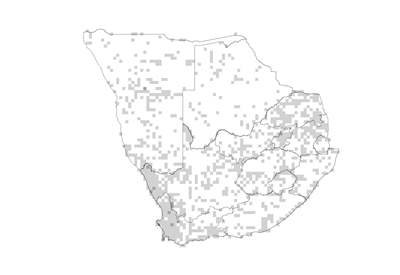 Species distribution and density. Darker squares represent higher density of members of this family. |
Introduction
Carpet weed family
The family Molluginaceae consists of herbs or dwarf shrubs with fleshy or succulent leaves. Species are widespread in southern Africa.
Distribution
Occurs mainly in the tropics and subtropics. Southern Africa is regarded the centre of diversity for this family with the highest diversity along the Namaqualand coast.
Number of genera in the world
ca. 16
Number of species in the world
ca. 120
Number of genera in the Flora of southern Africa region
10
Number of species in the Flora of southern Africa region
107
Well-known southern African genera
Adenogramma, Hypertelis, Limeum, Mollugo, Pharnaceum, Psammotropha.
Growth forms
Mostly herbs and dwarf shrubs.
Habitats
Mostly found in sandy places in arid areas.
Flagship species
Hypertelis salsoloides (haassuring [A]) is a frequently encountered species along the Namaqualand coast where it is specifically adapted to saline conditions, but it is also widespread over the Northern, Western and Eastern Cape provinces and Namibia where it is found in dry situations. It grows in sandy and brackish places and is abundant in disturbed areas. The blue-green succulent leaves and pink to white flowers make this an attractive little plant. The leaves have a sour taste and are eaten by domesticated animals but seldom by wild animals.
Significance of the family
This family is of little economic value. Many species have a 'weedy' nature and frequently invade disturbed places. Some species are important forage plants. The young leaves and stems of Glinus lotoides are used as a vegetable. Glinus and Mollugo are also used in traditional medicine. Limeum africanum is highly palatable and an indicator of well-managed veld. (Photo: HV).
Diagnostic characters
Leaves opposite, whorled or alternate without stipules or with membranous stipules. Flowers mostly small , regular with (4)5, green-white, sometimes pink or red, but usually white petaloid sepals �. Stamens 5-10, free . Ovary superior � with several locules; styles as many as locules. Fruit a capsule . (Photo : HV).
Did you know?
On the Galapagos Islands Mollugo is one of the first plants to establish on a bare lava field.